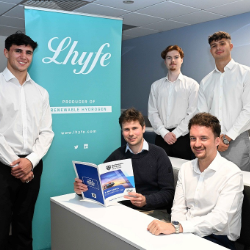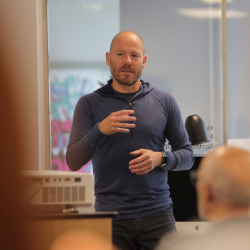-
Study
-
Quick Links
- Course Search
- Fees and Funding
- Unlock Your Potential
- Still time to Apply
- Higher and Degree Apprenticeships
- Continuing Professional Development
- Still time to apply
-
Undergraduate
- UCAS Clearing & Confirmation 2025
- Application Guides
- UCAS Exhibitions
- Foundation Years
- School & College Outreach
- Information for Parents
-
Postgraduate
- Application Guide
- Postgraduate Research Degrees
- Flexible Learning
- Change Direction
- Register your Interest
-
-
International
International
Northumbria’s global footprint touches every continent across the world, through our global partnerships across 17 institutions in 10 countries, to our 277,000 strong alumni community and 150 recruitment partners – we prepare our students for the challenges of tomorrow. Discover more about how to join Northumbria’s global family or our partnerships.
View our Global Footprint-
Quick Links
- Course Search
- Undergraduate Study
- Postgraduate Study
- Information for Parents
- London Campus
- Northumbria Pathway
- Cost of Living
- Sign up for Information
-
International Students
- Information for Students
- International Events
- Application Guide
- Entry Requirements and Education Country Agents
- Global Offices
- English Requirements
- English Language Centre
- International student support
- Cost of Living
-
International Fees and Funding
- International Undergraduate Fees
- International Undergraduate Funding
- International Masters Fees
- International Masters Funding
- International Postgraduate Research Fees
- International Postgraduate Research Funding
-
International Partners
- Agent and Representatives Network
- Global Partnerships
- Global Community
-
International Mobility
- Information for Northumbria Students
- Information for Incoming Exchange Students
-
-
Business
Business
The world is changing faster than ever before. The future is there to be won by organisations who find ways to turn today's possibilities into tomorrows competitive edge. In a connected world, collaboration can be the key to success.
More on our Business Services -
Research
Research
Northumbria is a research-rich, business-focused, professional university with a global reputation for academic quality. We conduct ground-breaking research that is responsive to the science & technology, health & well being, economic and social and arts & cultural needs for the communities
Discover more about our Research-
Quick Links
- Research Peaks of Excellence
- Academic Departments
- Research Staff
- Postgraduate Research Studentships
- Research Events
-
Research at Northumbria
- Interdisciplinary Research Themes
- Research Impact
- REF
- Partners and Collaborators
-
Support for Researchers
- Research and Innovation Services Staff
- Researcher Development and Training
- Research Ethics and Integrity
- University Library - Open Access
- Vice Chancellors Fellows
-
Research Degrees
- Postgraduate Research Overview
- Doctoral Training Partnerships and Centres
- Academic Departments
-
Research Culture
- Research Culture
- Research Culture Action Plan
- Concordats and Commitments
-
-
About Us
-
About Northumbria
- Our Strategy
- Our Staff
- Place and Partnerships
- Leadership & Governance
- Academic Departments
- University Services
- History of Northumbria
- Contact us
- Online Shop
-
-
Alumni
Alumni
Northumbria University is renowned for the calibre of its business-ready graduates. Our alumni network has over 246,000 graduates based in 178 countries worldwide in a range of sectors, our alumni are making a real impact on the world.
Our Alumni - Work For Us
What will I learn on this module?
This module aims to further develop your skills in electronic communications with specific reference to key techniques that are used in radio frequency (RF) communications. You will be exposed to the theory, design and analysis of all key aspects of RF and wireless communication systems.
All wireless communication systems consists of two key areas, namely high frequency circuit design and antenna design. Within high frequency circuit design
you will learn how to modify the performance of RF signals and will cover the key concepts of microwave circuit design for wireless and RF systems. Once the RF signal has been generated, it must then be converted to a signal that can be transmitted through air. This is the second key concept and will be covered in the second part of the module – namely antenna design and propagation. The antenna design section covers the key principles of transmitting an RF signal through free space. The antenna design topic also examines the key concepts of antenna design related to modern communication systems, including mobile telephone systems from 1G to 5G. A further key part of any mobile communication device is the interaction between circuit design and antenna design and will also be covered in this module.
For Microwave circuit design typical topics include: Transmission Line Basics, Smith Chart, Impedance Matching techniques, Lumped Elements, Impedance / Admittance parameters, ABCD parameters , S-parameters, Passive microwave circuits.
For Antenna design typical topics include: Basic antenna parameters, outline of antenna types, wires, apertures, dishes, patch antennas, antennas required for
mobile systems, Structure of Cellular systems. Base station design, Typical RF transmitter layout, Antenna types for mobile handset and base stations. Factors affecting reception.
How will I learn on this module?
This module will be delivered using a mixture of lectures supported by laboratories, workshops, online videos, together with directed learning and independent learning. An assignment is included to reinforce the theory provided in the lecture sessions.
Before each lecture you will be expected and encouraged to read ahead by reviewing the support material provided via eLP to support your own learning outside of timetabled hours. This will allow for meaningful discussions to take place during lectures.
Practical examples and analysis will be explored during lectures with active participation by students being employed. This will involve tutor lead Q+A sessions and student to student explanation and response at the front of class. A key element of learning on this module includes student led discussion of the key design principles and trade-offs associated with practical antenna design.
During the laboratory sessions you are presented with a design problem, typical of the types of problems faced in the engineering industry. An example of this is that you are given a brief to design a device for transmitting radio frequency signals. As an example, this could involve designing a high frequency antenna and integrate it with high frequency circuit design. Within this you will experience the entire design lifecycle including design, simulation, manufacture and testing of your device. You will complete the entire design process and present your results in the form of a final report and oral presentation. By following this process, you will develop key transferable skills that can be applied to most industries.
Directed learning for laboratory sessions will include comprehensive learning guides available for computer simulation packages.
Lab sessions will include detailed guided introduction to a wide range of practical Wireless and RF measurement systems.
How will I be supported academically on this module?
The module is delivered as noted in both lectures and workshops. These provide the key academic support to the module; however around this is built a number of support structures.
Workshops, supported by lab tutors, effectively provide verbal feedback and comments throughout the session. Such comments may be generic and applicable to you, typically noting procedures or some technical guideline or could be may be more directed to the individuals learning. Online screen videos are included on the eLP platform to help you understanding of key concepts related to this module.
The most appropriate use of blackboard (online platform) is made in the module where the module taught content is provided along with links to the reading list.
What will I be expected to read on this module?
All modules at Northumbria include a range of reading materials that students are expected to engage with. Online reading lists (provided after enrolment) give you access to your reading material for your modules. The Library works in partnership with your module tutors to ensure you have access to the material that you need.
What will I be expected to achieve?
Knowledge & Understanding:
1. Demonstrate the application of knowledge in the design of wireless and RF circuits and systems with application to real world problems. (AHEP4: , C1, C3)
Intellectual / Professional skills & abilities:
2. Simulate build and test RF circuits and antennas using simulation and practical lab equipment (AHEP4: C6, C12, M6, M12)
3. Analyse the specification and performance requirements necessary for the operation of wireless and RF links within a regulatory framework (AHEP4: C2)
Personal Values Attributes (Global / Cultural awareness, Ethics, Curiosity) (PVA):
4. Ability to convey technical information to a third party, including presentation skills both written and oral (AHEP C8, C9, C10, C17, C18, M8,M9, M10, M18)
How will I be assessed?
Summative assessed is by:
- coursework (CW) with an assignment which includes the practical design, measurement, analysis, and simulation of key components of a communication system.
- A presentation (PRE) will also be included to assess students understanding of the lecture material and application.
The assignment (covering LO1, LO2, LO3) will be worth 80% and the presentation (covering LO4) will be worth 20% of the module.
Formative assessment using e-portal software and e-learning tests within lectures.
Feedback occurs during lab sessions, workshops and via the e-learning portal.
Pre-requisite(s)
N/A
Co-requisite(s)
N/A
Module abstract
In this module you will study key aspects of mobile communication using wireless technology. You will be taught via lectures, which will be recorded live and will be available online for you to watch in your own time. You will also get to experience practical sessions in our state-of-the-art microwave facilities, which are highly regarded as being amongst the best in the UK. An example of what you will study includes what happens during a mobile phone conversation, whether you are using a 1G, 2G, 3G, 4G or 5G mobile phone. As technology is constantly evolving the syllabus is continuously updated to reflect this. Our academics are all heavily involved in researching new ideas and technology and this is reflected in our teaching, so you can experience the next generation of technology whilst it is still being developed.
Course info
UCAS Code H601
Credits 20
Level of Study Undergraduate
Mode of Study 3 years Full Time or 4 years with a placement (sandwich)/study abroad
Department Mathematics, Physics and Electrical Engineering
Location City Campus, Northumbria University
City Newcastle
Start September 2025 or September 2026
All information is accurate at the time of sharing.
Full time Courses are primarily delivered via on-campus face to face learning but could include elements of online learning. Most courses run as planned and as promoted on our website and via our marketing materials, but if there are any substantial changes (as determined by the Competition and Markets Authority) to a course or there is the potential that course may be withdrawn, we will notify all affected applicants as soon as possible with advice and guidance regarding their options. It is also important to be aware that optional modules listed on course pages may be subject to change depending on uptake numbers each year.
Contact time is subject to increase or decrease in line with possible restrictions imposed by the government or the University in the interest of maintaining the health and safety and wellbeing of students, staff, and visitors if this is deemed necessary in future.
Useful Links
Find out about our distinctive approach at
www.northumbria.ac.uk/exp
Admissions Terms and Conditions
northumbria.ac.uk/terms
Fees and Funding
northumbria.ac.uk/fees
Admissions Policy
northumbria.ac.uk/adpolicy
Admissions Complaints Policy
northumbria.ac.uk/complaints

.png?modified=20250630105204)







